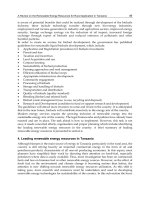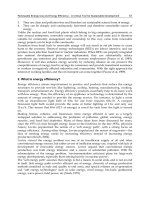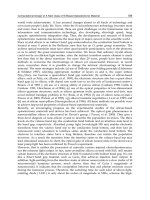Volume 4 fuel cells and hydrogen technology 4 09 – molten carbonate fuel cells theory and application
Bạn đang xem bản rút gọn của tài liệu. Xem và tải ngay bản đầy đủ của tài liệu tại đây (3.83 MB, 13 trang )
4.09
Molten Carbonate Fuel Cells: Theory and Application
T Leo, FuelCell Energy Inc., Danbury, CT, USA
© 2012 Elsevier Ltd. All rights reserved.
4.09.1
4.09.2
4.09.3
4.09.4
4.09.5
4.09.5.1
4.09.5.2
4.09.5.3
4.09.6
4.09.6.1
4.09.6.2
4.09.7
References
Introduction
Carbonate Fuel Cell Chemistry and System Configuration
Cell Stack and Power Plant Design
Advantages of MCFC Power Plants
Applications of MCFC Power Plants
Self-Generation Applications
Grid Support Applications
Renewable MCFC Power Plant Applications
Future Advanced MCFC Applications
Hydrogen Production – DFC-H2 Concept
Carbon Separation
Conclusions
Glossary
Anaerobic digester A system for disposing of organic
waste materials which uses bacteria to break down the
waste, producing methane and carbon dioxide
byproducts. Anaerobic digesters are used to process waste
at municipal wastewater treatment plants and at food
processing plants. The gas byproduct can be used as a fuel
in some systems, depending on the tolerance for the
carbon dioxide diluent.
Anaerobic digester gas The gas produced as a byproduct of
anaerobic digestion. The gas is typically 60 to 70% methane
with the balance being carbon dioxide, plus traces of sulfur
compounds and other impurities.
Anode An active fuel cell component functioning as a
negative electrode, where oxidation of fuel occurs,
producing electrons.
Cathode An active fuel cell component functioning as a
positive electrode, where reduction of oxidant and
consumption of electrons occurs.
Combined heat and power (CHP) An application of fuel
cells (or other types of power plants) where waste heat
produced during power production is used for applications
such as heating water, producing steam, or driving an
absorption chiller. This heat utilization avoids the use of
fuel, providing cost and carbon emission savings.
Direct FuelCell (DFC) A trade name for molten
carbonate fuel cell, which refers to the fact that
248
249
251
253
254
254
255
257
258
259
259
259
260
hydrocarbon fuels are sent directly to the fuel cell stack,
where they are reformed to hydrogen. In some other fuel
cell systems the reforming reaction has been done in a
pre-processor subsystem.
Distributed generation Electric power that is generated
where it is needed (distributed throughout the power
grid) rather than in a central location. Centrally generated
power requires extensive transmission networks, while
distributed generation does not.
Electrolyte A material which allows transport of ions from
anode to cathode. In the molten carbonate fuel cell the
electrolyte is a mix of alkali metal carbonates, and
carbonate ions are transported from cathode to anode.
Fuel cell A device which converts the energy value of a fuel
to electricity electrochemically, without combusting the
fuel. The functional components of a fuel cell are the
anode, the cathode, and the electrolyte matrix.
Matrix A thin porous layer between the anode and
cathode which contains the fuel cell electrolyte.
Molten carbonate fuel cell A fuel cell which uses mixed
alkali metal carbonates as the electrolyte. The fuel cell
operates at a high enough temperature for the carbonates
to become liquid and ionically conductive.
Reforming Catalytic conversion of hydrocarbon fuel
(such as pipeline natural gas or digester gas) to hydrogenrich gas. The hydrogen-rich gas serves as a fuel for the
electrochemical reaction.
4.09.1 Introduction
One of the earliest fuel cells to be deployed commercially are the molten carbonate fuel cells (MCFCs), which are high-temperature
fuel cells that operate with a variety of fuels with high efficiency and very low emissions. Research and development on the system
has been conducted since the 1950s, and demonstration and commercialization activities were underway by the late 1990s. The
current state of the technology is such that it is best used for baseload power generation in stationary power plant systems [1].
Comprehensive Renewable Energy, Volume 4
doi:10.1016/B978-0-08-087872-0.00408-X
247
248
Molten Carbonate Fuel Cells: Theory and Application
Commercial power plants based on MCFCs have been available since 2003, and there are currently more than 60 MW of
commercial power plants operating at more than 50 sites around the world.
The success of the technology is due to key features related to the high temperature of operation. The cells operate at 600–650 °C, higher
than phosphoric acid or PEM cells, but lower than SOFC fuel cells. At this temperature the reaction kinetics are such that the cells do not
need noble metal catalysts to achieve good performance, but the temperature is not so high as to require exotic alloys or ceramics as
materials of construction. The absence of noble metal catalysts reduces fuel cell stack cost and reduces sensitivity to fuel impurities and
carbon monoxide, which allows a high degree of fuel flexibility. The operating temperature is also high enough to allow hydrocarbon fuels
(e.g., natural gas or anaerobic digester gas (ADG)) to be used without an external reforming system. These fuels can be reformed to
hydrogen within the fuel cell stack. This increases system efficiency and reduces cooling system cost, since the reforming reaction is driven
by waste heat from the fuel cell reaction [2].
The following sections describe the operating principle of internal reforming MCFCs, followed by a discussion of actual power
plant configuration and applications.
4.09.2 Carbonate Fuel Cell Chemistry and System Configuration
The operating principle is described schematically in Figure 1. When configured in ‘internal-reforming’ systems, the electrochemical
cell stack is where hydrocarbon fuels are reformed into hydrogen. A mixture of fuel and water vapor is sent to the anode chambers of
the cells in the stack. Reforming and shift reactions occur, which convert the hydrocarbon fuel to hydrogen:
ΔH650ºC ¼ þ53:68 kcal g mol − 1
Reforming: CH4 þ H2 O →CO þ 3H2 ;
Shift: CO þ H2 O →CO2 þ H2 ;
Net: CH4 þ 2H2 O →CO2 þ 4H2 ;
ΔH650ºC ¼ −8:5 kcal g mol − 1
ΔH650ºC ¼ þ45:18 kcal g mol − 1
The overall conversion is endothermic, which helps provide thermal management to the fuel cell stacks. During power generation,
more than half of the waste heat produced by the fuel cell reaction is consumed in the reforming reaction. Water produced in the
fuel cell anode reaction provides additional reforming reactant, and since the hydrogen produced by the reaction is continuously
consumed in the fuel cell, the reforming/shift reaction is driven to completion, converting virtually all of the hydrocarbon fuel to
hydrogen. This complete conversion is obtained despite the fact that the fuel cell operates at significantly lower temperatures, and
with less steam input, than would be used in a conventional external reformer system.
The electrochemical reactions occurring in carbonate fuel cells are as follows:
�
�
At the anode. The H2 produced by the reforming reaction reacts with carbonate ion CO3 2 − and produces H2O and CO2 by the
reaction:
H2 þ CO3 2 − → H2 O þ CO2 þ 2e−
The CO2 produced in this reaction is sent back to the fuel cell cathodes by the power plant process system (described below).
Hydrocarbon fuels
Natural gas/Digester gas
Steam
Internal reforming
CH4 + 2H2O
Anode
4H2 + CO2
H2 + CO=
3
H2O + CO2 + 2e–
e–
Catalyst
Electrolyte
Catalyst
Cathode
e–
1/2O2 + CO2 + 2e–
Air
Figure 1 Carbonate fuel cell chemistry.
CO32–
Molten Carbonate Fuel Cells: Theory and Application
249
Power to grid
Electrical
balance of
plant
Mechanical
balance of
plant
DC/AC
conversion
Fuel &
water
preheat
Fuel cell
anodes
Catalytic
oxidizer
600 °C
370 °C
DFC
exhaust
Fuel cell
cathodes
Air
preheat
Fuel cell
stack
module(s)
Fuel
treatment
Air
Natural
gas or
biogas
Water
treatment
Water
Figure 2 Carbonate fuel cell power plant simplified process diagram.
At the cathode. Oxygen from air and carbon dioxide from the anode reaction are reacted to form CO3 2 − as follows:
�
1
−
2−
2 O2 þ CO2 þ 2e → CO3
The CO3 2 − ions formed on the cathode electrode are electrochemically transported to the anode, where they are consumed by the
anode reaction.
These cell reactions require a process system that provides heated fuel and oxidant reactants to the fuel cells at a proper flow rate,
and which provides a mechanism to deliver CO2 produced by the anode reaction to the cathodes. A number of different system
approaches are possible. FuelCell Energy (FCE) uses a system that leaves some fuel unutilized to serve as energy input to heat up
incoming air. The overall power plant process is shown schematically in Figure 2.
Water and hydrocarbon fuel (typically, natural gas or methane biogas) are treated to remove sulfur and other impurities, heated to stack
temperature, and sent to the fuel cell stacks. The reforming/shift reactions described above then convert the hydrocarbon fuel to hydrogen.
The stack anodes consume about 70% of the hydrogen produced by the reforming reaction. The residual 30% hydrogen is used to preheat
incoming air in a catalytic oxidizer. The heated air is then sent to the cathodes at a temperature of approximately 550 °C. Because the air was
mixed with the anode exhaust stream in the catalytic oxidizer, the cathode inlet gas contains the CO2 produced by the anodes, which is
required for the cathode reaction. After the cathode reaction, the cathode exhaust gas exits the fuel cell stacks at approximately 600 °C, and it
is used to provide the preheat to the incoming fuel and water streams, in the power plant heat recovery unit (HRU). The exhaust gases are
cooled to 370 °C in the HRU, and can then be used for a variety of waste heat applications, as described below.
The theoretical operating temperature of MCFCs at 650 °C is 1.03 V [3]. In practice, the cells typically operate at approximately
0.8 V per cell under rated load conditions. This voltaic efficiency, combined with the 70% coulombic fuel utilization efficiency, gives
a 54% DC power generation efficiency. After accounting for DC to AC power conversion losses and parasitic power requirements for
balance-of-plant systems, typical power plant fuel to AC power efficiency is just under 50% on a lower heating value (LHV) basis.
4.09.3 Cell Stack and Power Plant Design
Figure 3 is an illustration of the repeating cell components of the fuel cell stack. The anode and cathode electrode structures are thin
layers of porous nickel alloys. The electrodes are laminated on either side of a thin porous ceramic lithium aluminate substrate,
which holds the molten carbonate electrolyte within its pores.
250
Molten Carbonate Fuel Cells: Theory and Application
MATRIX
ANODE
OXIDANT
FUEL
CATHODE
BIPOLAR
PLATE
Figure 3 Carbonate fuel cell hardware.
The electrolyte is a mixture of alkali carbonates, which becomes liquid and ionically conductive at 450–510 °C. The pore structure of
the ceramic matrix, Ni anode, and Ni cathode layers are strictly controlled in order to achieve the desired distribution of electrolyte between
the three layers. Well-defined liquid–solid–gas interfaces in the cell structure provide the optimum amount of gas reaction sites and ionic
mobility. Development efforts to extend cell life have focused in large part on maintaining the desired pore size distribution over time.
Corrugated flow layers, made of 300-series stainless steel, are placed on either side of the anode/matrix/cathode lamination to
provide the required gas flow passages for anode fuel gases and cathode oxidant gases. Anode and cathode gases are separated by a
stainless steel bipolar plate, which also provides the series electrical connection from each cell to the next.
In current commercial fuel cell products, a cell stack consists of approximately 400 of these cell package structures. When stacked
together, the corrugations present gas inlet and exit passages on alternating faces of the stack. Figure 4 shows a photograph of a
commercial-scale stack, rated at 350 kW net AC output. When configured into a stack module, stainless steel manifolds are placed
against the appropriate stack faces to direct inlet gases or collect exit gas flows.
The cell package and stack structures shown in Figures 3 and 4 are typical of the MCFC technology commercialized by FCE in Danbury,
CT, USA. FCE (along with their partner in South Korea, POSCO Power) is currently the only company offering commercial fuel cell power
plants based on MCFC technology. FCE’s fuel cell system utilizes internal reforming, and it is called the Direct FuelCell (DFC) in reference
to the fact that hydrocarbon fuels are sent directly to the fuel cell stacks, without the need for an external reforming system.
Figure 4 Carbonate fuel cell stack.
Molten Carbonate Fuel Cells: Theory and Application
251
DFC300
Single Module
Powerplant
300 kW
Single-stack module
DFC1500
One 4-Stack
Module
1.4 MW
Cell package and
stack
Four-stack module
DFC3000
Two 4-Stack
Modules
2.8 MW
Figure 5 Carbonate fuel cell stack and power plant configurations.
FCE produces three standard power plant configurations based on the DFC design. The systems are designated DFC300,
DFC1500, and DFC3000 and produce 300, 1400, and 2800 kW, respectively. As shown in Figure 5, the standard power plant
systems utilize one of two modules: a single-stack module rated at 300 kW or a four-stack module rated at 1.4 MW. Both modules
use the same basic cell package and stack as described above.
All of the systems operate at 47% LHV electrical efficiency with new fuel cell stack modules. Current DFC fuel cell stack life is
5 years. During this time, the power plant output declines to 90% of the initial rated output value, and the electrical efficiency
declines by 10% (4.7 percentage points) to 42.3%. At the end of 5 years of operation, the stack modules are replaced with modules
with new cells, and initial performance levels are restored.
In addition to the stack module, two other subsystems are used in each power plant system. The mechanical balance-of-plant
section contains the process equipment that prepares air, fuel, and water for use in fuel cell stack modules. The electrical balance
of-plant section converts the DC power into high-quality AC power. Like other fuel cell systems, DFC power plants use solid-state
static inverter systems, which provide additional benefits to local grid power quality beyond the power conversion function.
Inverters have the ability to provide or absorb volt–ampere reactive power (VARs), have low frequency distortion, and low fault
currents. These features make fuel cells more easily integrated into grid systems as distributed resources compared with power
generation systems with rotating electric generators.
4.09.4 Advantages of MCFC Power Plants
DFC power plant systems compete against a wide variation of power generation technologies, including the default option: the
electric grid. As a new technology, DFC systems are often more expensive than conventional power generation options, but they
have key features which make them a good economic fit for many applications:
• High electrical efficiency, which results in reduced fuel costs and reduced carbon footprint per kilowatt-hour of generated power.
• High temperature waste heat, which can be used for a variety of purposes, improving economics and further reducing carbon
footprint.
• Low emissions and low noise, which facilitate distributed generation installations on-site near power and heat users.
The high electrical efficiency is put into perspective in Figure 6, which compares electrical efficiency for a variety of power generation
systems over a wide range of system sizes. No other commercially available power generation system can match the efficiency of fuel
252
Molten Carbonate Fuel Cells: Theory and Application
70
Efficiency, % (LHV)
60
Central generation
Grid support distributed
generation with
combined heat and
power
On-site distributed
generation with
combined heat and
power
cle
d Cy
bine
50
Com
MCFC
ells
uel C
emp F
40
Low T
es
Engin
Gas
e
Turbin
30
20
am
l/Ste
Coa
oMicr e
in
Turb
Average US
Fossil Fuel
Plant = 33%
10
0
0.1
1
10
100
1000
System size (MW)
Figure 6 Comparison of MCFC electrical efficiency with alternative power generation technologies.
1013 kW
High-grade use
1360 liters/hour hot water
heated from 110 to 120 C
Or
1200 kg/h steam at 520 kPa
Or
1340 kW absorption chilling
2800 kW
power
1580 kW
Low-grade heat use
1415 liters/hour water
heated from 15 to 32 C
90% total thermal
efficiency
64% total thermal
efficiency
560 kW
unused heat
Fuel
input
5957 kW
3157 kW
heat
177 °C
exhaust
38 °C
exhaust
370 °C
exhaust
DFC
powerplant
Figure 7 Thermal efficiency for typical combined heat and power options.
cells in distributed generation sizes. Combined-cycle power plants start to approach DFC efficiencies at sizes above 10 MW, but for
typical on-site power generation applications, DFC systems will be more efficient.
Beyond electrical efficiency, DFC systems are almost always deployed in combined heat and power systems, where waste heat in
the fuel cell exhaust is used to offset on-site thermal fuel use, further increasing efficiency and reducing carbon footprint. The 370 °C
exhaust can be used in heat exchangers to produce hot water, steam, or to provide energy to absorption chilling systems. Figure 7
illustrates the thermal balance for a number of heat recovery options that could be used with a DFC3000 2.8 MW system.
High-grade heat uses include hot water, steam, or absorption chilling. Enough energy is often left over to provide for low-grade
heat recovery to produce additional hot water or to provide other heating functions. In the examples shown in Figure 7, the highand low-grade heat uses result in a total thermal efficiency of 90% [4].
In addition to high electrical efficiency and high-grade waste heat, the third major advantage of DFC fuel cells is very low emissions.
Table 1 compares the emissions of DFC fuel cell power plants to other distributed generation options and the average US fossil fuel plant.
The fuel cell systems are orders of magnitude lower in NOx and particulate emissions compared with conventional power generation
systems. The high electrical efficiency also translates to low CO2 emissions (which become zero when renewable biogas fuel is used).
4.09.5 Applications of MCFC Power Plants
DFC power plant systems are deployed in applications that produce clean power using natural gas fuel or applications that produce
clean, renewable power using biogas-derived fuels. Applications can also be split into two other categories: on-site power generation
to reduce grid power use and power generation for export to the grid.
Molten Carbonate Fuel Cells: Theory and Application
Table 1
253
Comparison of DFC power plant emissions to conventional power generation sources
Average US fossil fuel plant
Microturbine (60 kW)
Small gas turbine (250 kW)
DFC fuel cell on natural gas
DFC fuel cell on natural gas with CHP
DFC fuel cell on biogas
NOx
(lb MWh−1)
SOx
(lb MWh−1)
PM-10
(lb MWh−1)
CO2
(lb MWh−1)
5.06
0.44
1.15
0.01
0.006
0.006
11.6
0.008
0.008
0.0001
0.000 06
0.000 06
0.27
0.09
0.08
0.000 02
0.000 01
0.000 01
2031
1596
1494
940
550
0
Source: Emissions estimates for nonfuel cell sources are from ‘Model Regulations for the Output of Specified Air Emissions from
Smaller-Scale Electric Generation Resources’, 15 October 2002, The Regulatory Assistance Project, for the National Renewable
Energy Laboratory (NREL) [5].
4.09.5.1
Self-Generation Applications
DFC power plants have been used in on-site power applications to meet the baseload power requirements of a wide range of
municipal, military, commercial, and industrial customers including wastewater treatment plants, manufacturing facilities, office
buildings, hospitals, universities, and military bases. Many of the earlier self-generation projects used the smaller DFC300 product,
but as the technology has been proven, the demand has been shifting to larger installations, which have a lower installed cost per
kilowatt. Figure 8 shows an example of a self-generation project at an industrial bakery in Connecticut. This early generation
DFC1500 system, rated at 1.2 MW, provides more than half of the facility’s power requirement, and excess heat from the power
plant is used to support bakery processes, offsetting fuel use in plant boilers. After the fuel cell exhaust flows through the steam
generator, it flows to another heat exchanger which is used to provide preheat to a facility gas stream. This two-level heat recovery
gives the project a very high thermal efficiency, enhancing the economics and greenhouse gas reductions achieved by the system. The
stack module can be seen in the right of the photograph, and the equipment on the left of the picture is the DC–AC power
conversion system. The power plant exhaust (in the center of the photograph) exits vertically and is then directed down and behind
the unit to the steam generation system.
Figure 9 shows another on-site combined heat and power (CHP) application, in this case a 1.4 MW DFC1500 at a university in
California. In this view, the hot water heat recovery system can be seen just behind the power plant equipment.
These are two typical examples of combined heat and power installations in on-site self-generation projects. This type of project
makes up about 40% of the 67 MW of MCFC power plants operating around the world. The remaining 60% are applications where
power is exported to the utility grid instead of consumed on-site.
4.09.5.2
Grid Support Applications
In the grid support market, power is sold into the electric grid, at prices set by feed-in tariffs or by pricing mechanisms under
Renewable Portfolio Standards (RPS) programs. These projects tend to be larger scale than the self-generation applications. The
Figure 8 DFC1500 power plant in combined heat and power application at industrial bakery in Connecticut.
254
Molten Carbonate Fuel Cells: Theory and Application
Figure 9 DFC1500 power plant in combined heat and power application on California State University, East Bay campus.
Figure 10 11.2 MW DFC power plant in Daegu City, South Korea.
DFC3000 power plant is often being used in multiple-plant configurations for grid support systems. The most significant grid
support market for fuel cells is in South Korea, where an RPS pricing mechanism provides favorable pricing for fuel cell power.
Figure 10 shows the largest fuel cell installation in the world, an 11.2 MW site with four DFC3000 power plants in Daegu City,
South Korea. The system produces power for sale to the local utility under a long-term power purchase agreement, and provides heat
to local neighborhood users. South Korea has supported fuel cell grid sales through a feed-in tariff mechanism which has now been
transitioned to a renewable energy credit (REC)-based pricing scheme under their national RPS program. In South Korea, the high
efficiency and very low emissions of fuel cell power plants qualify them for inclusion as renewable power, even when using natural
gas fuel. The same is true for the state of Connecticut in the United States (and four other states), which has a feed-in tariff type
program targeted at establishing 150 MW of renewable, clean generation in the state. The state of California is in the process of
enacting feed-in tariffs for combined heat and power and renewable power sources, which could support additional grid support
fuel cell installations.
Driven largely by the scale of the projects, the grid support application is the largest growing market segment for DFC fuel cell
power plants. Unlike the self-generation application, it is not always possible to identify local users for waste heat from these
grid-connected systems. Because of this, power plant developers have been evaluating approaches to converting waste heat from
the systems into additional power. One of the most straightforward of these approaches is to use DFC waste heat to drive an
organic Rankine cycle (ORC) system. An ORC is a power generation system similar to a steam turbine plant, except that it uses an
organic working fluid with lower boiling point than water, to capitalize on lower-temperature heat sources. ORCs are used to
Molten Carbonate Fuel Cells: Theory and Application
255
Figure 11 320 kW sub-MW DFC/T power plant during field test at Billings Clinic in Billings, MT.
recover industrial waste heat or to produce power from geothermal sources. When operated from the waste heat of a DFC power
plant, the additional power from an ORC bottoming cycle can increase the electrical efficiency of the power plant from 47% to
approximately 50%.
FCE has also developed a hybrid cycle in which a gas turbine generator is integrated into the fuel cell system at the point of
highest temperature (after the anode gas oxidizer) in order to achieve even higher efficiencies. The gas turbine is unfired, and
runs entirely on waste heat from the fuel cell process. The technology has been demonstrated at the sub-MW scale. Figure 11
shows a prototype system that was based on the DFC300 product (rated 250 kW at the time) combined with a Capstone
microturbine, for a combined rated output of 320 kW. The unit was tested at FCE’s Connecticut test facility and then operated
in the field at a hospital site in Billings, MT, USA. The maximum LHV electrical efficiency demonstrated was 58% [6]. The
hybrid system, designated the DFC/T, achieves a higher efficiency than exhaust-based bottoming cycles (like the ORC) because
it is driven by higher temperature heat in the fuel cell system. FCE is developing megawatt-scale DFC/T designs for
commercialization in the near future.
A high-efficiency configuration that is commercially available today involves the use of waste heat from DFC fuel cell systems to
support power generation from natural gas pressure letdown energy recovery. Natural gas is transmitted over long distances at high
pressure, and then reduced in pressure for distribution in local markets. This pressure reduction is done at gate stations near major
markets, and it is usually done with pressure reducing valves. Enbridge Inc., a major natural gas distribution company, and FCE have
codeveloped a hybrid system in which the pressure reduction is done in an expansion turbine, which drives an electric generator. In
order to prevent excess cooling of the expanding natural gas, waste heat from a DFC power plant is used to preheat the high-pressure
gas before expansion. This system, called the DFC-ERG (for Energy Recovery Generation) has been demonstrated at Enbridge’s
headquarter, Toronto, Canada, in a 2.2 MW system consisting of 1.2 MW fuel cell generation and 1 MW expansion turbine
generation. The maximum efficiency demonstrated by this system has been 70% on an LHV basis [7]. The power plant is shown
in Figure 12. The fuel cell system, with four single-stack modules, is shown in the foreground of the photograph, and the turbine
generation and heat transfer equipment is behind the fuel cell system.
4.09.5.3
Renewable MCFC Power Plant Applications
As described above, MCFC system currently available in the DFC configuration are designed for internal reforming of
methane-based fuels, which makes them a good fit for biogas fuels which are predominantly methane, such as ADG. ADG differs
from pipeline quality natural gas in that it has higher levels of contaminants, such as sulfur compounds and siloxanes, and the
methane tends to be diluted with CO2, another by-product of the anaerobic digestion process. ADG from municipal wastewater
treatment processes consist of about 60% methane and 40% CO2. ADG from brewery or food processing waste digestion has about
70% methane concentration [8].
MCFCs are particularly well suited for operation on these bio-derived fuels, due to its insensitivity to the CO2 diluent. As
described above, a unique aspect of the carbonate fuel cell chemistry is that CO2 is produced in the anodes and consumed in the
cathodes. Because of Nernst effects, the presence of CO2 diluent in the fuel will reduce anode performance and improve cathode
performance. In practice, the cathode gain is roughly equal to the anode penalty – the DFC power plants perform about the same in
the presence of the CO2 diluent, as long as methane content is above approximately 50%. Figure 13 compares performance from a
test stack operating on pure methane versus operation on methane diluted with CO2. The results show that the CO2 diluent had no
impact on cell performance. This has been born out in many commercial projects at municipal wastewater treatment plants using
ADG with 60% methane concentration. In fact, a small performance gain (vs. natural gas) has been observed at sites with 70%
methane/30% CO2 gas compositions, which suggests that at this concentration the cathode gain is slightly more than the anode
performance loss.
256
Molten Carbonate Fuel Cells: Theory and Application
Figure 12 2.2 MW DFC-ERG system in Toronto, Canada.
0.950
Average cell voltage
0.900
0.850
0.800
0.750
0.700
0.650
0.600
100% Methane
Simulated DG, 60% Methane/40% CO2
0.550
0.500
0.0
50.0
100.0
150.0
200.0
Current density (mA/cm2)
Figure 13 Stack performance on simulated dilute digester gas compared with pure methane fuel.
As of this writing, there are approximately 9 MW of DFC power plants operating on biogas at 11 sites around the world, mostly in
California. Most systems are at municipal wastewater treatment sites, but systems are also installed at food processors and breweries.
Figure 14 shows a 1.4 MW DFC1500 system at a municipal wastewater treatment plant at Turlock Irrigation District in California.
Figure 15 shows a system at a wastewater treatment facility in Tulare, California, consisting of three sub-MW DFC300 systems. After
several years of operating these systems, the municipality installed a fourth unit to utilize more ADG and increase the capacity of
power generation at the site [9].
Molten Carbonate Fuel Cells: Theory and Application
257
Figure 14 1.4 MW system at wastewater treatment site at Turlock Irrigation District, California.
Figure 15 900 kW system at wastewater treatment site in Tulare, California.
While executing the first biogas projects, FCE evolved a variety of control strategies and features to deal with the specific
characteristics of biogas. Unlike pipeline natural gas, the production and composition of the biogas fluctuates over time. Systems
have been developed to automatically respond to changes in composition by changing fuel utilization and air flow set points. A fuel
blending option has been introduced, which can substitute natural gas for ADG if the biogas production falls off, allowing the
power plant to continue operation at full power. Early biogas projects suffered from poor performance of the gas pretreatment
systems which remove excess sulfur from the gas. These lessons learned have been incorporated into design guidance, which is given
to customers who are specifying gas treatment systems for fuel cell power plants during the project development stage. This
refinement of the renewable fuel application is a key factor in the growth of this market segment, as successful projects inspire other
wastewater treatment plant or food processing operators to explore the technology. Agricultural-based biogas is a potentially large
emerging market segment, which could benefit from fuel cell power generation. Municipal wastewater treatment, food and beverage
processing, and agricultural operation all generate solid waste that can be reduced by digestion, and that digestion produces
methane gas that must be disposed of. Using the methane gas for power generation eliminates on-site flaring, and if that power
generation is in a fuel cell power plant, local generation of NOx and particulates is also eliminated. The unique insensitivity of
MCFC systems to the CO2 dilution in these fuels makes them a good match for these applications.
258
Molten Carbonate Fuel Cells: Theory and Application
4.09.6 Future Advanced MCFC Applications
Development programs are being conducted on future MCFC-based systems with additional features beyond generation of heat and
power. The two concepts being evaluated involve using MCFC-based systems to produce hydrogen, and using MCFC as a carbon
separation system for CO2 capture from conventional fossil plants.
4.09.6.1
Hydrogen Production – DFC-H2 Concept
As discussed earlier, in the internal reforming DFC system, hydrocarbon fuels are converted to hydrogen in the fuel cell stacks.
Most of the hydrogen is used in the electrochemical power generation reaction and the residual hydrogen is used to heat
incoming cathode air. In the DFC-H2 concept, most of the residual hydrogen is separated from the anode exhaust, and purified
for delivery to a hydrogen user. The user could be a hydrogen vehicle fueling station, an industrial hydrogen user, or a
low-temperature hydrogen fuel cell that provides additional power. The preheat of incoming air is done with a heat exchanger,
since the energy content of the residual fuel stream is no longer enough to heat up the air. DFC-H2 systems produce less usable
waste heat than a conventional DFC system (because some of the thermal energy has been used for air preheat), but they do
produce some waste heat, along with power and hydrogen. These tri-generation systems are sometimes referred to as combined
heat, hydrogen, and power (CHHP) systems.
The first full-scale DFC-H2 system was built in 2009, based on the 300 kW DFC300 configuration. Some of the fuel cell
power is used to power the hydrogen separation system, so the net output of the DFC-H2 system is 250 kW, and it
produces up to 250 kg day−1 of hydrogen. The system was tested at FCE’s Connecticut facilities in 2010, and then delivered
to the Orange County Sanitation District (OCSD) wastewater treatment facility site in California for field testing and a
3-year operation test [10].
Figure 16 shows the system on test at the OCSD site. The DFC-H2 system can produce clean hydrogen from natural gas, with less
carbon emissions than conventional hydrogen production from steam methane reforming, because the reforming heat is coming
from fuel cell waste heat, not fuel burning. The system can also be operated on renewable fuel, as the OCSD system is, with no
carbon impact. At the OCSD site, the renewable hydrogen produced by the system is used to fuel hydrogen vehicles at a filling
station located nearby. The project is led by Air Products, which also operates the on-site vehicle fueling station. In addition to FCE
and Air Products, this demonstration project is also supported by the National Fuel Cell Research Center at the University of
California Irvine, California Air Resources Board (CARB), South Coast Air Quality Management District (SCAQMD), US
Department of Energy (DOE), and Southern California Gas Company.
In the system shown in Figure 16, the fuel cell equipment can be seen to the left of the photograph, and the hydrogen
separation and storage equipment is to the right. The system separating hydrogen from the anode exhaust is a pressure swing
absorption (PSA) system, which is a modification of conventional separation technology. FCE is also developing an electro
chemical separation system that could reduce the cost and energy requirements of the hydrogen separation section of the
system.
4.09.6.2
Carbon Separation
The carbonate fuel cell chemistry includes the unique characteristic that CO2 is produced at the anode electrodes and consumed at
the cathode electrodes to support the transfer of carbonate ions through the electrolyte. This aspect of MCFC operation can be used
as a carbon transfer mechanism to separate carbon from a dilute stream and transfer it to a more concentrated stream where it can be
Figure 16 DFC-H2 power plant producing 250 kW and over 250 kg day−1 of hydrogen and power derived from renewable ADG at Orange County
Sanitation District, California.
Molten Carbonate Fuel Cells: Theory and Application
259
more easily separated. Investigations are being conducted to determine if this concept can be used to efficiently capture CO2 from
fossil power plant exhaust.
Carbon capture and sequestration is of great interest in countries that depend on fossil fuels for a significant portion of the
power generation mix. Conventional systems to extract CO2 from power plant exhaust require a significant portion of the plant
electrical output to operate. The MCFC carbon capture application involves sending the exhaust from a fossil plant to the
oxidant inlet of an operating MCFC power plant. The CO2 in the exhaust would be consumed by the cathode reaction, and an
equivalent amount of CO2 will be produced in the anodes. This effectively transfers CO2 from the dilute power plant exhaust
stream (where CO2 concentration ranges from 5% to 15%, depending on the type of plant) to the anode exhaust stream. The
CO2 concentration in the anode exhaust stream is approximately 70%, and it can be more easily separated from this more
concentrated stream.
Cell tests have been done to quantify the performance of operating cells with oxidant gases based on simulated composition of
exhaust gas from various types of coal and natural gas power plants. These results are now being used in modeling studies to predict
system performance as an input into economic evaluation of the concept.
4.09.7 Conclusions
MCFCs have achieved a high degree of success because of inherent aspects of the fuel cell chemistry: high efficiency, high-grade
waste heat, and very low emissions. Market adoption is broadening as customers become familiar with the technology and
comfortable with deploying large-scale systems. This trend, combined with the emergence of new advanced applications of
the technology, should make the MCFC the first fuel cell technology to play a significant role in the stationary power
generation mix.
References
[1] McPhail S, Bove R, and Moreno A (2008) ‘International Status of Molten Carbonate Fuel Cell (MCFC) Technology’; 2008 ENEA Ente per le Nuove Tecnologie, l’Energia e
l’Ambiente Lungotevere Thaon di Revel, 76 00196 Roma.
[2] Farooque M and Maru HC (2006) Carbonate fuel cells: Milliwatts to megawatts. Journal of Power Sources 160(2): 827–834.
[3] DE-AM26-99FT40575 (2004) Fuel Cell Handbook, 7th edn. EG&G Technical Services, Inc., US Department of Energy, NETL, November 2004.
[4] Pais C and Leo A (2009) CHP applications of high temperature fuel cells. World Energy Engineering Congress. 4–6 November 2009. />[5] National Renewable Energy Laboratory (NREL) (2002) Model regulations for the output of specified air emissions from smaller-scale electric generation resources, 15 October
2002. The Regulatory Assistance Project, for the National Renewable Energy Laboratory (NREL).
[6] Ghezel-Ayagh H (2008) Direct FuelCell/turbine power plant. Final Technical Progress Report, DOE DE-FC26-00NT40798. US Department of Energy, NETL.
[7] Enbar N and Jaffe S (2010) Best Practices: Enbridge’s Approach to Greening the Natural Gas T&D Network via Hybrid Fuel Cells. Energy Insights No. EI221326.
[8] Mossinger T (2008) Cogeneration and fuel cells, water and wastewater. In: Air, Water, Energy Conference, California Water Environment Association. April 2008.
(last accessed 19 December 2011).
[9] Fuel Cells (2000) Fuel cell system turns waste into electricity at the Tulare wastewater treatment plant. www.fuelcells.org/info/TulareCaseStudy.pdf (last accessed 19 December
2011).
[10] Heydorn E (2011) Validation of an integrated Hydrogen Energy Station. Section VII.4 of US Department of Energy Hydrogen and Fuel Cell Program 2011 Annual Progress Report.
Available at: (accessed 20 December 2011).









